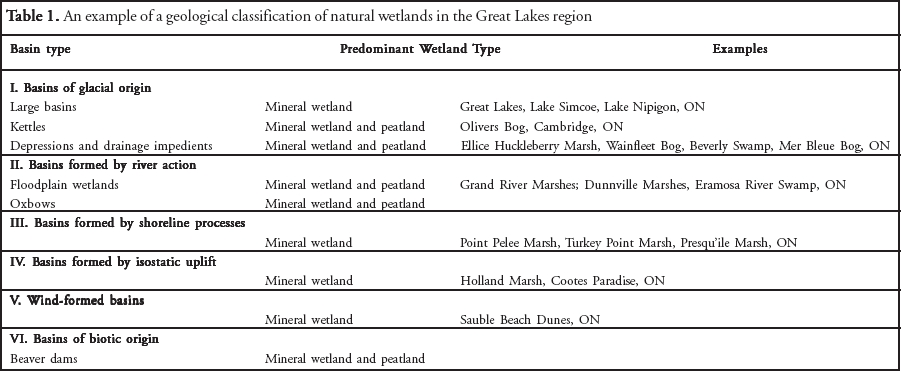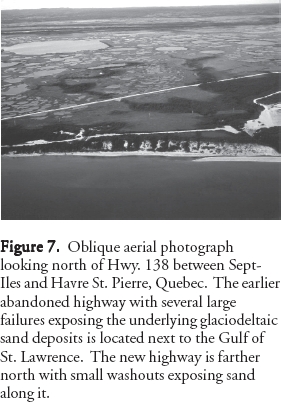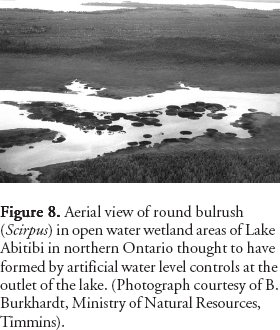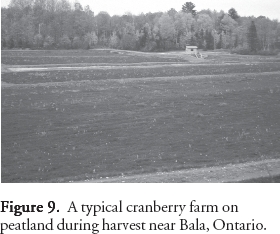Geology of Canadian Wetlands
Barry G. WarnerWetlands Research Centre, University of Waterloo, Waterloo, Ontario N2L 3G1
bwarner@uwaterloo.ca
Accepted as revised 15 March 2004
SUMMARY
Wetlands have not gained as much attention as they ought to by geologists despite being so prevalent in the Canadian landscape. Some of this stems from a poor understanding of wetland geology and what wetland landforms are. Wetlands constitute unusual landforms in that they are formed of biological material predominantly shaped by biological processes rather than being formed of minerals and rock shaped more by physical processes. There are two main groups of wetlands: mineral wetlands, commonly situated in high-energy settings; and peatlands, situated in low-energy settings that undergo either terrestrialization or paludification during the course of their development. Wetlands, as both a landscape unit and economic resource, have historically been and will continue to be important in Canada. New and more specialized skills and engineering designs will be required to build infrastructure in wetland terrain. Wetlands should be regarded as an economic resource that requires wise use and management. Nature-sensitive technologies need to be invented for use with wetlands to conserve and enhance the resource to serve the needs and protect the health of human society.RÉSUMÉ
Bien qu'elles constituent un trait dominant du paysage canadien, les géologues n'ont pas prêté suffisamment d'attention aux terres humides. Cela tient en partie à une mauvaise connaissance de la géologie des terres humides et de ce que sont ces éléments géomorphologiques. Comme éléments géomorphologiques, les terres humides ont ceci de particulier qu'elles sont principalement constituées de matériaux biologiques issus de processus biologiques, et non de minéraux et de roches formées par des processus physiques. Il existe deux grands groupes de terres humides, soit les terres humides minérales, généralement situées en milieux de hautes énergies, et les tourbières, situées en milieux de basses énergies, et dont le développement comporte une étape de terrestrialisation ou de tourbification. Tant comme élément topographique que ressource économique, les terres humides ont été et demeurent importantes au Canada. Des savoirfaire techniques nouveaux et plus spécialisés seront nécessaires pour concevoir et édifier des infrastructures en milieux humides. On devrait voir les terres humides comme une ressource économique devant être gérer avec sagesse. Il est nécessaire que des technologies douces soient inventées pour conserver la ressource et en tirer un meilleur parti tout en protégeant la santé humaine.
INTRODUCTION
1 Wetlands occur where an excess of water saturates soils and collects at shallow depths on the land surface long enough to sustain waterlogged conditions. Geological characteristics determine how the water reaches the land surface and where it is distributed in watersheds. Where and how water is situated within wetlands, especially peatlands, is controlled by physical characteristics of the peat. Origins, composition and stratigraphy of wetland deposits depends on dissolved chemicals and materials derived from erosion and deposited from their surroundings. The rate and mode by which the sediment and peat has accumulated and decomposed through time, and how this carbon-rich material is stored are addressed using common geological and paleoecological tools. Further, these tools can be applied to elucidate more precisely what and how the geological connections are with wetlands, and what if any, the relationships are between the vast array of different wetland types. Wetlands are intimately connected to the surroundings of their individual basins and to their watersheds. The geology of wetlands focuses on understanding these relationships (Moore, 2001).
2 The importance of geology in wetland science seems to have escaped the attention of most geologists, despite covering about 15% and being a distinctive part of the Canadian landscape. Part of the problem is that wetlands have long been an enigma. Are they landforms, soil units, water features or vegetation communities? The answer is yes, to all of the above. Wetland science can be thought of as an amalgamation of all of these disciplines. Up until a decade or two ago, it was not possible to provide clear answers to these questions. Today, wetland science has become more refined and widely accepted as a distinct and unique discipline in the environmental sciences. A wetland classification system, begun in the 1970s, was an important development for defining and recognizing wetlands in Canada (Warner and Rubec, 1998). Though much remains to be learned about the intricacies of wetland hydrology, biogeochemistry, and biology, and its linkages with other environmental phenomena such as climate, natural and human-induced disturbances, and global sea levels, little advancement can be made in wetland science without regard for the important role of geology.
3 Canadian geologists were once far more involved with wetlands than today, and indeed, played a leading role in wetland studies in the early 1900s. The early interests revolved around geological surveys and economic evaluations of peat resources in the country. There is as much need today as there was in the early 1900s for Canadian geologists to be involved with wetlands and to re-assume their leading role, especially in view of current environmental and economic issues, such as climate change, landscape rehabilitation, sustainable wise use of economic resources, surface water and groundwater conservation and protection, and public and occupational health concerns. Perhaps the wane in interest in wetland geology in recent decades may be due to the narrow historical perception that geologists need only play a role with regard to peat as an economic resource and not with much broader issues such as understanding the origin, character, development, and management of the overall wetland resource in a country like Canada, whose wetlands are vast and varied.
4 Wetlands have historically been regarded as obstacles to development. Their widespread occurrence in this country has made it nearly impossible to avoid them. Technical and engineering skill, ingenuity, and luck have been instrumental in shaping Canada as it has come to be today. Engineers are moving away from their early and more traditional approaches that focussed on draining wetlands. Plans and designs now ensure that wetlands remain intact, and indeed, engineers are restoring and creating wetlands. This new outlook indicates an acceptance of the challenges of working with wetlands in the landscape and inventing new, more nature-sensitive technologies and codes of professional practice.
5 This paper examines what wetland geology is and points out how geology is related to wetland landforms in the Canadian context. There is discussion of some of the engineering and environmental applications of wetland geology. Wetland geology is far more relevant than is typically assumed. More geology needs to be included in high school and university courses that deal with wetlands and more wetland science needs to be included in courses on Quaternary and environmental geology and courses on related subjects. Governments at all levels need to accept a greater responsibility for ensuring care of Canada's valuable wetland resources for future generations. Much more needs to be done to increase awareness among both professionals and average Canadians of the relevance of linking geology and wetlands as biological landforms.
EARLY WORK IN CANADIAN WETLAND GEOLOGY
6 Much of the early work on wetlands in Canada focused on peatlands. Initial interests were primarily from entrepreneurs and engineers who investigated ways to mine and process peat for fuel (Warner and Buteau, 2000). The first commercial peat mining operation was establishing in 1864 on a bog near Victoriaville, east of Montreal, Quebec. Individual operations were started in Ontario, Newfoundland, and elsewhere in Quebec, but all of these operations ceased by 1877.
7 Interest in the use of peat for fuel was renewed in the 1890s but this interest was temporary. The fledgling peat industry at the turn of the century lobbied the federal government for assistance. This action prompted the Geological Survey of Canada to investigate the peat industry in Europe (Nyström 1908). The government purchased a small peat mining plant from Sweden for $50,000 and set it up in 1907 on the Alfred bog near Ottawa. Scandinavian geologists were hired by the Geological Survey of Canada to undertake national surveys of Canada's peatland resources. A series of reports were published over the next 25 yearsor so (e.g. Anrep, 1914, 1915, 1927; Auer, 1930; Haanel, 1923, 1925; Moore, 1908; Nyström, 1908; Nyström and Anrep, 1909). There was so much interest in peatlands during this period that a Canadian Peat Society was formed in 1911. This early society had no connection with the current Canadian Society for Peat and Peatlands, which began in the 1970s.
8 There was little interest in peatland geology during this early period outside of the Geological Survey of Canada. Ganong (1897) in New Brunswick and Lewis and Dowding (1926) in Alberta studied the stratigraphy and fossils preserved in peatlands. The advent of pollen analysis during this period in Europe, quickly led to collection of peat cores and publication of the first pollen diagrams in Canada (Auer, 1930; Bowman, 1931; Janson and Halfert, 1937; Hansen, 1940).
OCCURRENCE AND DISTRIBUTION
9 The general pattern and geographic extent of wetlands became much better understood once a scientific definition and a wetland classification framework were developed for Canada (Canadian National Wetland Working Group, 1988; Warner and Rubec, 1998). Inventories reveal that about 14% of the Canadian land surface and 125 X 106ha is covered by wetlands, about 12% and 110 X 106 ha of which are peatlands, making Canada the most peatland-rich country in the world (Fig. 1; Tarnocai et al., 2000, 2001). About 18% of the world's wetlands occur in Canada (Tarnocai et al., 2001). These figures for the most part do not include freshwater wetlands along the shores of lakes, banks of rivers, in estuaries and along the marine coasts.
10 There is a striking match between the peatland map of Canada (Fig. 1) and a map showing areas covered by proglacial lakes and inland seas (Fig. 2). The flat till plains and clay, silt and sand glaciolacustrine and glaciomarine plains laid down in large inland lakes and seas created poorly drained areas that have contributed to the widespread wetlands in Canada today. A notable example is in the southern parts of the Hudson and James Bay basins, where proglacial lake and seabed deposits have contributed to development of one of largest peatland complexes in the world.
11 There are obvious anomalies, notably in the south-central Prairies, southern Ontario, and the Ottawa-St. Lawrence valleys, where there are till plains and glaciolacustrine and glacio-marine clay, silt and sand deposits but few peatlands today. These regions, in fact, did support widespread wetlands and/or peatlands in the historical past, which subsequently became filled in, ploughed over, and drained. These regions, however, are especially good for wetland restoration and creation because the underlying glaciolacustrine and glaciomarine deposits provide good foundation material on which to reestablish wetlands. Other anomalies exist on the hyper-oceanic north coast of British Columbia and in Newfoundland and the east coast of Labrador where there are no significant glaciolacustrine and glaciomarine deposits but peatlands are common. Peatlands have arisen on these coasts because a hypermaritime climate sustains abundant precipitation and low evaporation, allowing peat to form directly over the impervious bedrock.
12 Table 1 shows how geological attributes can be used as criteria for a simple wetland classification in one part of the country. An extension of this kind of geological classification is to include sediment composition, stratigraphic, and paleoecological characteristics into what in Europe has been termed geo-hydrological or biogenetical classifications (e.g. Succow and Lange, 1984).
Figure 1. Distribution of peatlands in Canada (after Tarnocai et al., 2000). The extent of peatland compares well with the wetland map of Canada (Tarnocai et al., 2001), given that about 85% of Canada's wetlands are peatlands. The heavy lines on the map delineate the major drainage basins.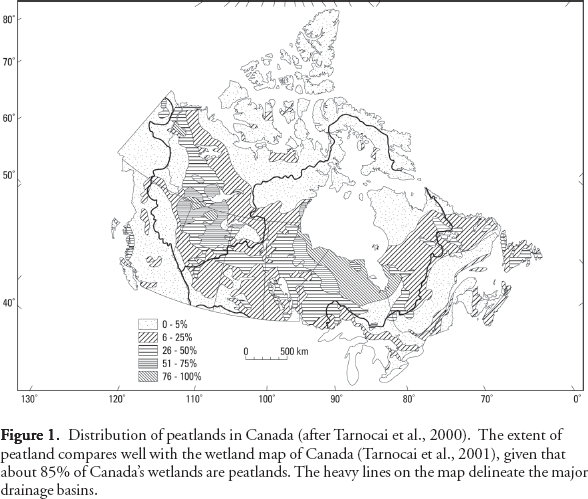
Display large image of Figure 1
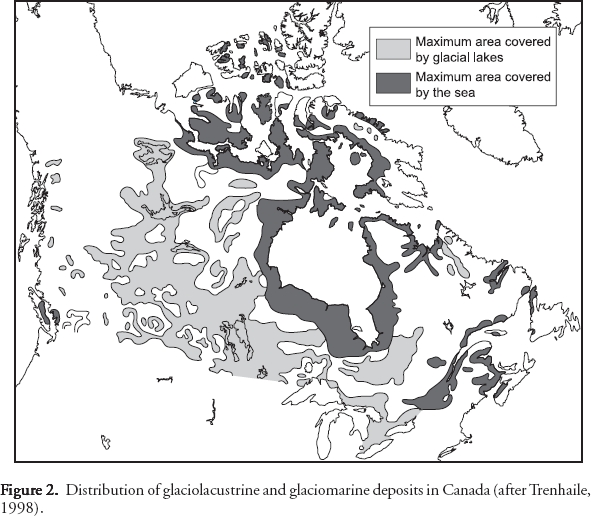
Display large image of Figure 2
Table 1. An example of a geological classification of natural wetlands in the Great Lakes region
WETLAND LANDFORMS
13 All landforms comprise solid material, gases and water. The most obvious difference between wetland landforms and all others is a predominance of water and organic or biological materials, most of which is peat, rather than the usual mineral or nonbiological materials (Warner 2003b). Some wetland landforms contain more organic material than others, and some are wetter than others, but constitute landforms nonetheless.
14 Wetland landforms have to be treated differently from the typical mineral landforms because biological processes dominate them. Wetland landforms have two primary structural layers. There is an outer or surface layer of soil with living plants, microbes and other biota, and a deeper layer comprising the dead remains of the biological inhabitants that once were part of the surface layer. Oxygen content is many orders of magnitude greater in the surface layer than in the deeper layer. The lower boundary of the surface layer is usually indicated by the lowest position of the water table in any given year. The upper boundary may be a water surface in the case of the wettest wetlands or the top of the living vegetation canopy in the case of the driest peatlands. The presence of living biota in the surface layer has led to wetlands being referred to as living landforms, and as such, they are dynamic and constantly changing.
15 Two broad types of wetland landforms have been distinguished in Canada. One group is organic wetlands, typically referred to as peatlands (Fig. 3a). Bogs and some fens and swamps are peatlands. Peatlands have a well-developed surface layer that has been described as having as many as six sub-units within it (Clymo, 1983; van Dierendonck, 1992). The surface layer in permanently frozen peatlands is more complicated, but probably can be thought of as having at least two distinct subunits, because the depth to permafrost table and depth to water table may be the same during dry periods and the water table can lie above the permafrost table during wet periods (Vardy et al., 2000). Water-logging or not above the permafrost table, therefore, affects oxygen conditions and the opportunity for peat material to survive decomposition and longer term accumulation. Much more work is needed to understand peat accumulation processes in permanently frozen peatlands. The term acrotelm has been used to refer to this surface layer in bogs (Ingram, 1978).
Figure 3a. A typical wetland landform and the structure of the internal layers: peatland.
Display large image of Figure 3a
16 There is no maximum thickness for the deeper layer. Depths of 12 m have been recorded in Canada, the thickest known from peatlands in the Mackenzie River Valley (Tarnocai et al., 2000) and from a kettle hole near Cambridge, Ontario (Warner et al., 2004). Catotelm has been used to refer to the deeper layer in bogs (Ingram, 1978). The deeper layer determines the overall size, shape, composition and storage capacity of the peat landform, while the surface regulates the growth and formation of peat materials and accumulation processes by selecting and regulating which dead biota will reach and become stored as peat in the deeper layer below it.
17 The second type of wetland landform is mineral wetlands, which have a surface layer of living biota and most often are inundated, by definition, with no more than 2 m of water. They have either a thin and poorly developed or a complete lack of a deeper layer of accumulated organic material (Fig. 3b). In Canada, a minimum measurement of 40 cm for thickness of the two layers is used to separate peatland from mineral wetland (Warner and Rubec, 1998). Marshes, shallow open water, and some fens and swamps are mineral wetlands.
Figure 3b. A typical wetland landform and the structure of the internal layers: mineral wetland.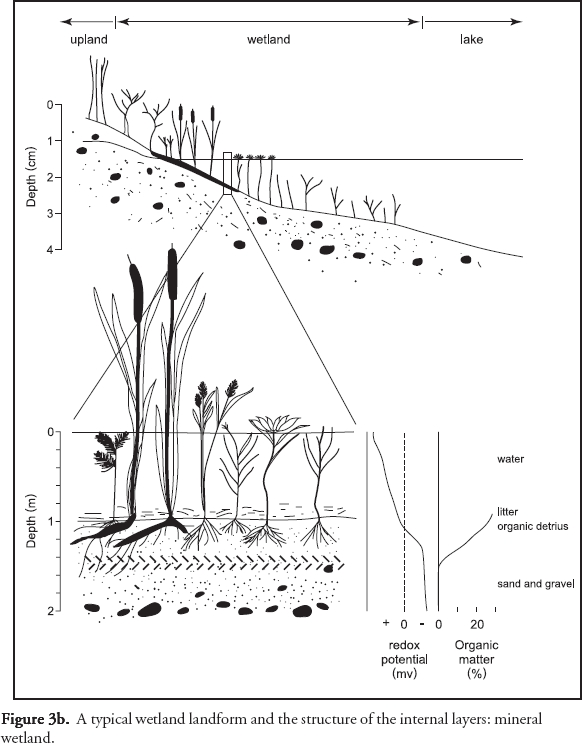
Display large image of Figure 3b
18 The water in both peatlands and mineral wetlands can be either permanently frozen, as is the case in permafrost regions, intermittently frozen for some years and not others, or only seasonally frozen. Both mineral wetlands and peatlands can be either permanently or intermittently covered by water for all or part of the year.
LANDFORM ORIGINS AND DEVELOPMENT
19 Most wetlands in Canada originate as mineral wetlands. Geological setting ensures that a steady supply of water remains on the land surface, enough to support wetland biota, thereby determining where wetlands occur in the landscape. Climate is also important because it can both supply and remove water, and so too, determines how much water is stored on the land surface. If either geological setting or climate does not allow water to stay on the land surface, a wetland will not form, or if either of these factors changes once a wetland has formed, the wetland will cease to exist.
20 Most peatlands develop out of mineral wetlands. Mineral wetlands occur in high-energy settings and often exchange water with adjacent landscape units (i.e., lakes, rivers or oceans). Peatlands occur in low-energy settings and are more independent of adjacent landscape units. Site-specific features of the hydroperiod and geochemistry of the waters influencing the site will determine the specific type of peatland that will develop from the mineral wetland, be it swamp, fen or bog. Eventually, a deeper layer of peat will become well developed, and organic materials will continue to accumulate and be added to the lower layer during the lifetime of the peatland.
21 Peatlands may also develop out of lakes. The term terrestrialization is used to denote the process of basin-infilling whereby a lake transforms into open water wetland and thereafter a peatland. A key attribute in the terrestrialization process is the position of the water table in the basin relative to the surface of the sediment. The water table is highest relative to the surface of the organics during the lake stage and early stages of wetland development. As organic matter continues to accumulate it reaches the water table, at which point the wetland develops into marsh, fen or swamp. The precise time at which lake becomes wetland, the timing of change from one wetland phase to another, and the nature of the final stage in the terrestrialization sequence is dependent upon the size and depth of the basin and the hydrological setting, assuming climatic factors or some other external force (e.g. human disturbances) does not interrupt the terrestrialization processes.
22 The ongoing accumulation of organic materials in the deeper layer may eventually cause a peatland to outgrow the physical confines of its basin. As the deeper layer thickens and moves out of the basin, it will essentially convert into peatland what was originally terrestrial land around the basin. This process is referred to as paludification. It is possible that overflowing peat from two adjacent basins may coalesce, thus producing a single peat landform out of the original two smaller separate peatlands. The large peatland landscapes and peat landforms in Canada represent mature landform complexes that grew out of many smaller independent wetland basins and depressions.
23 Raised bogs and some plateau bogs are good examples of peatlands that have outgrown their original basins (e.g. Warner et al., 1991). The net result is that the top of these landforms is higher in the center than in the periphery. A steady supply of precipitation is required to sustain the biota and peat accumulation processes. The dependence on precipitation as the only source for nutrients has led to specialized biota adapted to survival in nutrient-poor growing conditions.
24 In regions influenced by permafrost, water migrates along the thermal gradient from warm to cold, thereby feeding ice in the frozen core. The combined annual addition of peat along with an expanding ice core may cause these peatlands to grow beyond the confines of its basin and the surface to grow higher than its edges. Palsas and high-centred polygonal peatlands are examples of permanently frozen peatlands.
25 Terrestrialization and paludification processes have been going on throughout all of postglacial time (e.g. Bunting and Warner, 1998). These processes can be quite predictable provided climate, human activities or some other external factor has not altered the geological-hydrological-biological balance in the wetland system. However, the stratigraphic records of many peatlands reveal that there have been many interruptions to this balance, which has steered off course the "natural" direction and rate of the terrestrialization or paludification pathway. Peatlands are important repositories of paleoenvironmental information (Warner and Bunting, 1996). As such, they can be long-term sensors and archives of climatic shifts (e.g. natural and human-induced), geomorphic changes (e.g. sea levels, isostatic adjustments), natural catastrophes (e.g. storms, hurricanes, volcanic eruptions), and human activities (e.g. early cultures, land uses, pollution). The preserved disarticulated paleobiological indicators in the peat and organic sediment or geochemical markers in the peat and deep interstitial waters have been the primary tools for reconstructing these past events. The widespread abundance of peatlands makes them valuable archives of past events for many periods in pre- and postglacial time and at differential spatial scales for most of Canada.
26 It would be very useful if mineral wetlands and peatlands were differentiated on geological maps. At least 100 different wetland types occur in Canada (Warner and Rubec, 1998), Further recognition of terrestrialized and paludified wetlands would greatly refine wetland mapping and interpretation of landscape origins.
AGE AND RATES OF CHANGE
27 Wetlands represent landforms of various ages. Their organic composition presents an added benefit in that they can be used to age themselves, their internal archival records, and by inference, adjacent landscape units. The high-energy depositional environment and lack of a steady accumulation of organic materials makes it difficult to determine the age of mineral wetlands. This may also be a problem for peatlands whose early histories included a mineral wetland phase. For the most part, peatlands provide good dating control and continuous chronologies for large time spans, if not for their entire lifetime.
28 It is common in geology to regard the age of the bottommost organic sediments in wetlands as minimal estimates for the time of deglaciation or withdrawal of proglacial water bodies. This may be reasonable in situations where wetland inception occurred early, but not where wetland inception was delayed because climatic, geological, hydrological or biological factors caused a lag in wetland formation. Such lags are probably more common in Canada than might be expected because paludification, a major process responsible for peatlands throughout central Canada, did not become widespread until Middle to Late Holocene time in the central Boreal Ecozone (Vitt et al., 2000) and likely in other regions of the country too (e.g. Warner et al., 1991).
29 Not all peatlands will continue to grow indefinitely so it is equally important to determine the time at which peatland growth ceases. The age of the surface of permanently frozen peatlands throughout the Arctic and Subarctic Ecozones has been shown to be many thousands of years (Zoltai and Tarnocai, 1975; Vardy and Warner, unpublished). As such, some peatlands are relict landforms, no longer actively accumulating peat, while other peatlands may even be slowly degrading, some even back to their mineral wetland origins. Another example is swamps in southern Ontario where the near-surface peat is old. The surface layer has been "running on the spot" with no net addition of new materials reaching the deeper accumulation layer (Warner, unpublished).
30 It is especially important to understand the role of humans during the historical past on wetland developmental processes. Human activities, both direct and indirect, have been important in interfering with and even halting developmental and peatland growth processes. Alternatively, human activities may be responsible for setting up conditions conducive to wetland formation or accelerating developmental processes (e.g. Warner et al., 1989). Geologists have an important role to play in assessing human impacts on wetlands, because not all intact wetlands are as natural or pristine as we might assume.
31 Clymo's (1984) studies on peat accumulation and peatland growth started a whole new way of thinking of peat accumulation processes. His models were applied for the first time in North America on a site in New Brunswick, the most comprehensively dated peatland in North America (Warner et al., 1993). Subsequently, a number of studies on both the short-term and long-term peat accumulation processes have been undertaken in Canada (e.g. Belyea and Warner, 1996; Frolking et al., 2001) but there remain considerable gaps in our knowledge about peat accumulation processes in permanently frozen peatlands (Zoltai and Tarnocai, 1975; Vardy et al., 1996).
32 Peat is about 50% carbon (as dry matter). To understand peat accumulation is to understand carbon accumulation and storage in peatlands. Northern wetlands, especially peatlands, play a major role in global carbon cycles and climate change because they fix carbon from atmosphere in the biomass of the living vegetation. When the vegetation dies, the dead biomass eventually becomes peat in the surface layer where it is subjected to decomposition. That fraction remaining accumulates as peat in the deeper layer where it is stored for millenia. Canadian peatlands contain approximately 262 Gt of organic carbon, which is about 59% of the total carbon stored in Canadian soils (Tarnocai 1998). Canada contains about 18% of the worlds wetlands (Tarnocai et al., 2001) which means that Canada contains a significant proportion of the global terrestrial carbon pool. Geologists havea major role to play in assessing peatland carbon stocks, characterizing the dynamics of carbon cycling, and developing predictive models of carbon and climate change in Canada (Gorham, 1991; Frolking et al., 2001; Blodau, 2002). It would seem there is great value in differentiating "dead" and "living" wetland landforms and giving special conservation status to those systems most active in removing atmospheric carbon and sequestering the carbon as peat. Other important questions revolve around changes between carbon cycling processes, degree of climate changes, and occurrence and distribution of permafrost. How accurate are our inventories or complete is our knowledge of the extent and dynamics of perennially frozen wetlands, estimated to occupy approximately 42%? How might climate warming affect the carbon balance in these systems (Tarnocai, 1999)?
ENGINEERING AND ECONOMIC GEOLOGY
33 Wetland resources are important to the development and economic prosperity of Canada and play pivotal roles in supporting a prosperous and vital wetlands industry today (Warner, 2003a). It is difficult to avoid wetlands completely because they are so widespread and as such present major environmental and engineering challenges. The general tendency historically has been to drain wetlands and convert them to dry land if they got in the way. In recent years, this attitude has changed with realization of the positive values of both natural and of created and restored wetlands.
Excavations and construction
34 Wetlands pose special concern as foundation material for construction of buildings, roads, pipelines, bridges, and other structures. If at all possible, the best solution is to excavate and remove wetland materials altogether. In cities and towns where construction has been rapid and care has not been taken to recognize and remove wetland deposits prior to construction, or where fill has been dumped on top of wetland deposits, buildings have been subjected to severe structural damage by settlement (White and Karrow, 1998). Buried wetlands may continue to undergo decomposition and lose volume decades after construction, causing further instability around structures. Low-lying former wetland basins continue to discharge groundwater around structures. Construction in and around wetlands may lead to slope failure and flowage. The saturated wetland deposits are susceptible to frost heave and subsequent damage to structures.
35 Many of Canada's largest cities and towns are situated along rivers and coastlines of lakes and oceans where wetlands were once located. A good example is the heavily populated north shore of Lake Ontario, where one-time natural wetlands have been obliterated by fill or have been severely altered by increased sediment loads from streams and rivers flowing into the lake, readjustments to natural longshore drift processes, and artificial changes in lake water levels following construction of the St. Lawrence Seaway. Thorough knowledge of these new geological processes and their interactions with the adjacent land and runoff patterns is required to ensure successful restoration and creation of wetlands along the modern shorelines, which have been entirely created by humans. Much has been learned about wetland restoration and creation in recent decades in this heavily populated region of the country that can serve as models for other regions (Fig. 4; Canadian Wildlife Service 2002).
Figure 4. Southward view across Second Marsh near Oshawa, an example of a restored mineral wetland along the north shore of Lake Ontario. A baymouth bar with a small opening (top of photograph) separates the wetland from the open lake.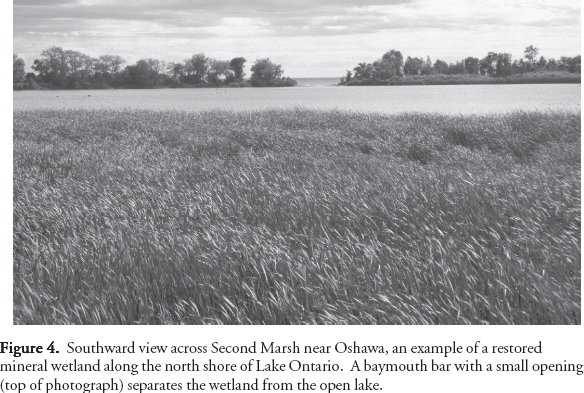
Display large image of Figure 4
36 The construction of roads across wetland terrain has resulted in a number of problems. Historically, common practice was to lay down timbers to form a corduroy road bed (Fig. 5). Natural drainage is commonly obstructed by roads, leading to flooding on the upstream side of the road and drying out on the downstream side if natural surface and subsurface flows are not preserved by the installation of culverts and other structures. If the soft, compressible peat is not removed prior to construction (Fig. 6), the road can shift and settle because of differential dewatering, decomposition, and degassing of underlying organic deposits. Also, it is possible that new wetland plants will colonize the ditches and roadsides immediately after construction, growing so rapidly within a single season or two that they block culverts and other drainageways. This problem can lead to flooding of the road or erosion problems. Also, special designs of roadbed through wetlands in permafrost terrain are required to protect the thermal regime in the underlying substrates (e.g. Radforth and Burwash, 1977; Keyser and Laforte, 1984). Similarly, special construction designs and maintenance plans are required for pipelines and railroads constructed across permafrost-influenced wetlands (Burgess and Tarnocai, 1997).
Figure 5. An abandoned corduroy road constructed in the early 1900s across peatland on Graham Island, Queen Charlotte Islands, British Columbia.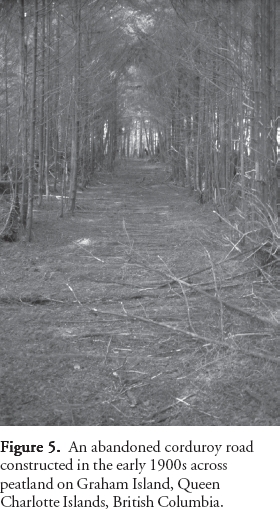
Display large image of Figure 5

Display large image of Figure 6
37 Construction of provincial highway 138 between Sept-Îles and Havre St. Pierre on the north shore of the Gulf of St. Lawrence is a good example of problems associated with road construction unique to peatland terrain. Roads that settle, sink or slide in this region have been constant sources of frustration to engineers (Fig. 7). Despite attempts in the early 1980s to construct a new highway with care to preserve water flow patterns, the culverts still shifted and sank below the surface. Massive landslides continued to carry the highway into the adjacent Gulf of St. Lawrence. The highway developed large potholes and irregular bumps and hollows. Thus, a new highway was again attempted in the early 1990s, this time farther inland from the Gulf of St. Lawrence, where it might be less prone to landslides. It took three years to build because extra loading was used to allow the roadbed to settle gradually before laying down the hard surface. Problems appeared within two months of the road opening. Many of the bog pools surrounding the highway dried up. Later investigations proved the existence of widespread iron oxide placic layers that were impervious to the peatland waters above in the natural terrain. Under the placic layers were 10s of meters of stratified glaciodeltaic sands and silts. It was later determined that road construction itself or subsequent vibrations of traffic using the highway pierced the iron oxide placic layer, allowing water from peatland pools to drain into the underlying sand and silt, thereby causing the sand and silt to liquefy and fail. Had geologists and engineers been aware that iron oxide placic layers are common phenomena associated with peatlands, they might have known what to look for in the field and be better prepared to take precautions to preserve them.
Figure 7. Oblique aerial photograph looking north of Hwy. 138 between Sept-Iles and Havre St. Pierre, Quebec. The earlier abandoned highway with several large failures exposing the underlying glaciodeltaic sand deposits is located next to the Gulf ofSt. Lawrence. The new highway is farther north with small washouts exposing sand along it.Water resources
38 Wetlands contain large quantities of water and regulate both surface and groundwater flows of water that would otherwise run off rapidly. Historically, a great deal of effort was directed towards drainage and increasing runoff within and around wetlands. The result has been a distortion of runoff patterns, land drainage, flooding, channelization, alteration of water ages, and inter-catchment water transfers of surface waters in watersheds of the country.
39 Wetlands may overlie important groundwater aquifers, especially on moraines, eskers, and fluvioglacial deposits. One such example is the Oak Ridges moraine north of Toronto, which supports numerous wetlands and important aquifers used by the dense population around it (Sharpe et al., 2002).
40 The complex biogeochemical transformations that occur in wetlands have the ability to attenuate contaminants in runoff waters coming from a variety of human activities. Therefore, wetlands are important for protecting surface and ground waters and drinking water supplies (i.e. Devito et al., 2000).
41 Dam and reservoir construction may destroy large areas of wetlands and contribute further to distorting runoff volumes and patterns. There is special concern, especially in the central part of the country where reservoirs for hydroelectricity flood wetlands. Other water level control structures may alter natural water levels that cause changes to natural wetlands (Fig. 8). Flooding induces a change in redox conditions in organic soils that mobilizes and converts natural mercury into methyl-mercury, which becomes readily available to reservoir biota, including fish, and humans who eat the fish. Flooding may increase greenhouse gas emissions (Rosenberg et al., 2000). Flooding by hydroelectric reservoirs is especially detrimental to permanently frozen peatlands because the overall permafrost regime is completely altered or obliterated.
Figure 8. Aerial view of round bulrush (Scirpus) in open water wetland areas of Lake Abitibi in northern Ontario thought to have formed by artificial water level controls at the outlet of the lake. (Photograph courtesy of B. Burkhardt, Ministry of Natural Resources, Timmins).Mining
42 Commercial mining of peat started in 1864 in Quebec (Warner and Buteau, 2000). Early activities were for peat fuel, but Canada overtook the world market for horticultural peat after World War II when European supplies were no longer available. Ontario and British Columbia were once the leading peat-producing provinces. Ontario had 11 commercial peat operations and today has none. Some of these operations might have survived if they had done the necessary geological fieldwork to characterize the peat and the nature of the deposit more carefully, rather than simply assuming that all peats were the same.
43 Quebec, New Brunswick and Alberta are the three leading peat-producing regions today (Keys, 1992). Peat mining is concentrated on the plateau and raised bogs along the north and south shores of the St. Lawrence River and around the Gulf of St. Lawrence. The wet and cool oceanic climate readily supports fast-growing Sphagnum mosses, peat-forming processes and development of peat landforms. Raised bogs that developed on clay deposits of the ancient LaFlamme Sea in the Lac St. Jean Region of Quebec have given rise to good peat deposits. Basin bogs and swamps are being used in the vicinity of Edmonton for horticultural peat, where the hot dry summers in western Canada facilitate its drying and collection.
44 Peat is also processed into a number of products some of which have been tried but not all of which have become commercially viable in Canada (Table 2). Such products include peat pots, boards, pellets, briquettes, soil conditioners, fertilizers, carbon-based filters, and golf tees. Peat-based compounds have been used for medicines and therapy (i.e. peat baths), growth stimulators, food additives (i.e. yeasts, carbohydrates), waxes and sealers, lubricants, and reagents, which have been extracted from Sphagnum peat.
45 Mining of peat and wetland deposits as "black earth" for gardens and potting mixes continues in many regions on a small scale. This activity can create problems for wetland conservation near densely populated regions, where many wetlands have been lost or altered by humans.
Agriculture
46 The rich nutrients and abundant water where mineral wetlands and peatlands with alkaline soils were cleared and drained support some of Canada's most productive vegetable and fruit growing areas (Table 2). The Holland Marsh on the southern edge of the Lake Simcoe basin was originally a Carex rostrata fen and Alnus swamp in the early 1900s, before farmers established vegetable gardening for the southern Ontario market. The bogs, fens, and estuarine marshes in the Lower Fraser Valley and Fraser Delta of British Columbia support large vegetable growing operations. Where peat soils are more acidic, such as in Newfoundland, crushed limestone and fertilizers are added to make them suitable for the same kind of crops.
Table 2. Some uses of wetlands.
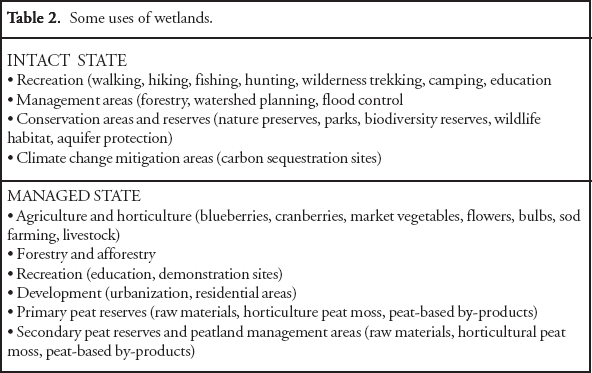
Display large image of Table 2
47 The acidic and peat-rich soils of bogs in southern Nova Scotia, the Lac St. Jean region of central Quebec and interior British Columbia support some of the largest cranberry growing operations in the country (Fig. 9). Cranberry production on peatlands in the Lower Fraser Valley represents British Columbia's largest berry crop. Cloudberry (Rubus chamaemorus) and thimbleberry (Rubus idaeus) are harvested from bogs in Quebec for juice and liqueur production. Wild-rice (Zizania aquatica), another wetland crop, is harvested on a commercial basis in the marshes and open water wetlands of northwest Ontario and southern Manitoba.
Figure 9. A typical cranberry farm on peatland during harvest near Bala, Ontario.Wetland Ecotechnology
48 Ecological engineering, also referred to as ecotechnology, is an emerging new field in Canada (Warner and Li, 1998; Kells and Warner, 2000). This technology is fast becoming the way of the future to bring the needs of human society together with the need of maintaining a healthy living environment. Wetlands ecotechnology combines engineering design and modeling principles with concepts of applied and fundamental ecology by creating systems that duplicate or simulate natural wetland systems while performing specific needs of humans. Wetland ecotechnology can be used to deal with environmental pollution, water-control problems, biodiversity and habitat issues. There is a wide range of designs that can vary from being relatively low-energy demanding systems through to ones that are very sophisticated wetland systems requiring manufactured energy and continuous maintenance to operate.
49 Drought conditions in the 1930s in the Prairies caused many wetlands to disappear (Leitch, 1978). Catastrophic population declines in waterfowl and other wildlife dependant upon wetlands were common. This necessitated restoration of wetland habitat. Thus began the use of wetland ecotechnology techniques in Canada. Wetlands have been used to rehabilitate quarries, aggregate pits, tailings ponds and abandoned mine sites – other ways of repairing degraded landscapes and reversing historical trends of lost wetland habitat.
50 Wetland technology as a passive, above ground alternative to conventional wastewater treatment and water quality improvement system is gaining much attention. The first systems were constructed in 1979 in Ontario and Saskatchewan (Kells and Warner, 2000). Today there are hundreds of fully-operational, pilot scale and experimental systems across the country.
CONCLUSIONS
51 Canada contains more wetland than any other country in the world, and Canadian geologists and engineers have an opportunity and responsibility to take a lead in advancing wetland knowledge and technological development. Geologists have a role to play in our national carbon inventory because the net carbon stored in our wetlands greatly exceeds the carbon stored in our forests and agricultural soils. How or if wetland carbon is priced in economic terms for sale and trade on the world market has yet to be determined, but could prove to be important in assisting Canada to meet its international obligations to off-setting carbon emissions now that Canada has ratified the Kyoto Protocol.
52 There are a number of major wetland issues in the world that geologists need to be aware of because it is probably only a matter of time before Canadians may be confronted with similar problems. For example, there is a large oxygen depleted zone at the mouth of the Mississippi River in the north-central Gulf of Mexico that has caused major economic losses to fisheries. The "dead-zone" is attributed to agricultural nutrients and high sediment input brought about by the loss of wetlands throughout the entire Mississippi basin (Rabalais et al., 2002). A major program has been initiated to restore wetlands throughout the whole drainage basin, especially in riparian zones along stream and river courses to control erosion and nutrients reaching the Gulf of Mexico (Mitsch et al., 2001). It is not that long ago that Lake Erie was considered "dead". How can we best use wetlands in Canadian agricultural landscapes to help with controlling runoff and attenuating nutrients? Might more wetlands have helped to protect surface and drinking water supplies from deadly agricultural-derived pathogens in the Walkerton disaster?
53 Mobilization of natural mercury and its entry into the human food chain by hydroelectric reservoirs flooding of peatland terrain is another way that wetlands relate directly to human health issues. The natural source of the mercury has not been confirmed in all cases, though it is suspected to be in the parent soils and bedrock and undergoes geochemical transformation when soils become anaerobic by flooding (St. Louis et al., 1994).
54 When they are set ablaze, wetlands pose serious natural health hazards by contributing smoke andhaze. The burning peatlands of south Florida, USA, Kalimantan, Indonesia, and around Moscow, Russia are recent examples of global significance illustrating the magnitude of threats to human health. Many of the forest fires that occur annually in northern and central Canada include peatlands. Fires, large and small, are important for the ecological integrity of many natural ecosystems including wetlands, but the magnitude and intensity of fires, exacerbated by drought conditions in recent years, will continue to require watchful care in the near future. Coastal wetlands along the eastern seaboard of the USA are being eroded at extremely high rates for reasons not yet clearly understood (Hartig et al., 2002). The problem has recently attracted the media attention with feature presentations by CNN Television. Is it possible that parts of the Canadian coast and its wetlands farther north are disappearing at similar rates? High peat cliffs on the coasts of New Brunswick and Prince Edward Island are clear examples of coastal wetland loss by transgressing sea levels (Fig. 10).
Figure 10. Peat cliffs at Point Escuminac, New Brunswick. The cliffs are being eroded by transgressing sea levels exposing a continuous history of 10,000 years of peat accumulation in this plateau raised bog (Photography courtesy of K. Tolonen)
Display large image of Figure 10
55 Wetlands are central to terrestrial water cycles. Damming of rivers continues to be a problem because it changes river flow volumes, increases time taken to drain to the oceans which causes the water to age and change ecosystems, and there are alterations to natural biota and biodiversity. River diversions and channelization may connect flows across drainage divides. In many parts of the world, water control structures have fallen into disrepair and require replacement or renovation. The alternative is to abandon the structures, which presents the need to restore rivers and clean old reservoirs. Wetlands should be considered in the context of both cause for change and consequence of such changes in construction and reconstruction plans.
56 Widespread spring flooding, which seems to be common in Canada, is a direct result of the way humans have modified the natural land surface. Would more wetlands and natural vegetation cover have been able to store more spring meltwater, reduce surface flows, and save the enormous property loss in such recent floods as in the Saguenay area of Quebec or around Winnipeg and the southern Prairies?
57 Every Canadian probably comes in contact with wetlands, either directly or indirectly, on a daily basis. Wetlands are distinctive features of the Canadian landscape and are part of our identity. We have always had to deal with wetlands, whether we wanted to or not, and we will continue to need to do so. Wetland geology is probably more important than ever because we now know that wetlands are unique and distinctive parts of the landscape and specialized knowledge and skill is required to deal with the many new environmental and economic issues that will be facing Canadians in years to come.
ACKNOWLEDGEMENTS
Many of the ideas presented in this paper have been generated by research undertaken with support from the Natural Sciences and Engineering Research Council of Canada. I thank my students and research colleagues for their contributions, and journal reviewers for providing useful critiques of the manuscript.REFERENCES
Anrep, A., 1914, Investigation of the peat bogs and peat industry of Canada 1911-1912: Mines Branch, Canada Department of Mines Bulletin v. 9, p. 1-47.
Anrep, A., 1915, Investigation of the peat bogs and peat industry of Canada 1913-1914: Mines Branch, Canada Department of Mines, Bulletin v. 11, p. 1-185.
Anrep, A., 1927, Peat bogs for the manufacture of peat litter and peat mull in southwest British Columbia: Geological Survey of Canada, Department of Mines, Summary Report, 1927, Part A, p. 53-61.
Auer, V., 1930, Peat bogs in south-eastern Canada: Geological Survey of Canada, Memoir, v. 162, p. 1- 32 p.
Belyea, L.R. and Warner, B.G., 1996, Temporal scale and peat accumulation in a Sphagnum bog, northwestern Ontario, Canada: Canadian Journal of Botany, v. 74, p. 366-377.
Blodau, C., 2002, Carbon cycling in peatlands – A review of processes and controls: Environmental Reviews, v. 10, p. 111-134.
Bowman, P.W., 1931, Study of a peat bog near the Matamek River, Quebec, Canada, by the method of pollen analysis: Ecology v. 12, p. 695-708.
Bunting, M.J. and Warner, B.G., 1998, Hydroseral development in southern Ontario: Development and controls: Journal of Biogeography, v. 25, p. 3-18.
Burgess, M.M. and Tarnocai, C., 1997, Peatlands in the discontinuous permafrost zone along the Norman Wells pipeline, Canada, in Iskandr, E.A., ed., Proceedings of the International Symposium on Physics, Chemistry and Ecology of Seasonally Frozen Soils, Fairbanks, Alaska: U.S. Army Cold Regions Research and Engineering Laboratory Special Report 97-10, p. 417-424.
Canadian National Wetland Working Group, 1988, Wetlands of Canada. Polyscience Publishers, Montreal, 452 p.
Canadian Wildlife Service, 2002, Where land meets water: Understanding wetlands of the Great Lakes: Canadian Wildlife Service, Environment Canada, Downsview, Ontario, 72 p.
Clymo, R.S., 1983, Peat in Gore, A.J.P., ed., Ecosystems of the world: Mires: swamp, bog, fen and moor, 4A: Elsevier Scientific Publishing Co., Amsterdam, p. 159-224.
Clymo, R.S., 1984, The limits to peat growth: Philosophical Transactions of the Royal Society of London, Series B, v. 303, p. 605-654.
Devito, K.J., Fitzgerald, D., Hill, A.R., and Aravena, R., 2000, Nitrate dynamics in relation to lithology and hydrologic flow path in a river riparian zone: Journal of Environmental Quality, v. 29, p. 1075-1084.
Frolking, S., Roulet, N.T., Moore, T.R., Richard, P.J.H., Lavoie, M. and Muller,S.D., 2001, Modelling northern peatland decomposition and peat accumulation: Ecosystems, v. 4, p. 479-498.
Ganong, W.F., 1897, Upon raised peat-bogs in the province of New Brunswick: Royal Society of Canada, Transactions Part IV, v. 2,p. 59-77.
Haanel, B.F., 1923, Peat resources of the Central Provinces and their utilization for fuel purposes: Canadian Institute of Mines and Metallurgy, Monthly Bulletin, v. 131, p. 83-111.
Hansen, H.P., 1940, Paleoecology of two peat bogs in southwestern British Columbia: American Journal of Botany, v. 27, p. 144-149.
Hartig, E.K., Gornitz, V., Kolker, A., Mushacke, F. and Fallon, D., 2002, Anthropogenic and climate-change impacts of salt marshes of Jamaica Bay, New York City: Wetlands, v. 22, p. 71-89.
Ingram, H.A.P., 1978, Soil layers in mires:Functions and terminology: Journal of Soil Science, v. 29, p. 224-227.
Janson, E. and Halfert, E., 1937, A pollen analysis of a bog in northern Ontario: Papers of the Michigan Academy of Arts, Sciences and Letters, v. 22, p. 95-98.
Kells, J. and Warner, B.G., 2000, The emergence of ecological engineering and green technology in Canada: The Canadian Civil Engineer, v. 17, p. 11-13.
Keys, D., 1992, Canadian peat harvesting and the environment: North American Wetlands Conservation Council, Issues Paper, v. 1992-3, p. 1-29 p.
Keyser, J.H. and Laforte, M.A., 1984, Construction and performance of pavement over muskeg: National Research Council, Washington, Transportation Research Record, v. 978, p. 68-80.
Leitch, W.G., 1978, Ducks and men: Ducks Unlimited Canada, Winnipeg, MB, 268 p.
Lewis, F.J. and Dowding, E.S., 1926, The vegetation and retrogressive changes of peat areas (muskegs) in central Alberta: Journal of Ecology, v. 14, p. 317-341.
Mitsch, W.J., Day, J.W., Gilliam, J.W., Groffman, P.M., and Hey, D.L., 2001, Reducing nitrogen loading to the Gulf of Mexico from the Mississippi Basin: Strategies to counter a persistent ecological problem: Bioscience, v. 15, p. 373-388.
Moore, E.V., 1908, Some notes on the development of the peat fuel industry and its possibilities: Transactions of the Canadian Society of Civil Engineers, v. 22, p. 82-119.
Moore, P.D., 2001, Wetlands: Facts on File Inc., N.Y., 200 p.
Nyström, E., 1908, Peat and lignite – Their manufacture and uses in Europe: Canada Department of Mines, Mines Branch, Ottawa, ON.
Nyström, E. and Anrep, A., 1909, Investigation of the peat bogs and peat industry of Canada during the season 1908-1909: Mines Branch, Canada Department of Mines, Bulletin, v. 1, p. 1-25.
Rabalais, N.N., Turner, R.E., and Wiseman, W.J., 2002, Gulf of Mexico hypoxia, a.k.a. "The Dead Zone": Annual Review of Ecology and Systematics, v. 33, p. 235-263.
Radforth, N.W. and Burwash, A.L., 1977, Transportation in Radforth, N.W. and Brawner, C.O., eds., Muskeg and the northern environment: University of Toronto Press, Toronto, p. 249-263.
Rosenberg, D.M., McCully, P., and Pringle, C.M., 2000, Global-scale environmental effects of hydrological alterations: Introduction: Bioscience, v. 50, p. 746-751.
Sharpe, D.R., Hinton, M.J., Russell, H.A.J., and Desbarnts, A.J., 2002, The need for basin analysis in regional hydrogeological studies: Oak Ridges Moraine, southern Ontario: Geoscience Canada, v. 29, p. 3-20.
St. Louis, V.L., Rudd, J.W.M., Kelly, C.A., Beaty, K.G., Bloom, N.S., and Flett, R.J., 1994, Importance of wetlands as sources of methyl mercury to boreal forest ecosystems: Canadian Journal of Fisheries and Aquatic Sciences, v. 51, p. 1065-1076.
Succow, M. and Lange, E., 1984, The mire types of the German Democratic Republic in Moore, P.D., European mires: Academic Press, London, p. 149-175.
Tarnocai, C., 1998, The amount of organic carbon in various soil orders and ecological provinces in Canada in Lal, R., Kimble, J.M., Follett, R.F., and Stewart, B.A., eds., Soil processes and the carbon cycle: CRC Press, Boca Raton, FL., p. 81-92.
Tarnocai, C., 1999, The effect of climate warming on the carbon balance of crysols in Canada: Permafrost and Periglacial Processes, v. 10, p. 251-263.
Tarnocai, C., Kettles, I.M., and Lacelle, B., 2000, Peatlands of Canada: Geological Survey of Canada, Open File Report 3834, scale 1:6,500,000.
Tarnocai, C., Kettles, I.M., and Lacelle, B., 2001, Wetlands of Canada: Agriculture and Agri-Food Canada, Research Branch, scale 1:6,500,000.
Trenhaile, A.S., 1998, Geomorphology: A Canadian perspective: Oxford University Press, Toronto, 340 p.
Van Dierendonck, M.C., 1992, Simulation of peat accumulation: An aid in carbon cycling research?: Suo, v. 43, p. 203-206.
Vardy, S.R., Warner, B.G., and Aravena, R., 1997. Holocene climate effects on the development of a peatland on the Tuktoyaktuk Peninsula, Northwest Territories. Quaternary Research v. 47,p. 90-104.
Vardy, S.R, Warner, B.G., Turunen, J. and Aravena, R., 2000: Carbon accumulation in permafrost peatlands in the Northwest Territories, Canada: The Holocene, v. 10,p. 273-280.
Vitt, D.H., Halsey, L.A., Bauer, I.E. and Campbell, C., 2000, Spatial and temporal trends in carbon storage of peatlands of continental western Canada through the Holocene: Canadian Journal of Earth Sciences, v. 37, p. 683-693.
Warner, B.G., 2003a, Canada's wetland industry, in Rubec, C.D.A., ed., Wetland stewardship in Canada, Contributed papers from the conference on Canadian wetlands stewardship: North American Wetlands Conservation Council (Canada), Report 03-02, p. 81-92.
Warner, B.G., 2003b, Peat in Middleton, G.V., Church, M.J., Coniglio, M., Hardie, L.A., and Longstaffe, F.J., Encyclopedia of sediments and sedimentary rocks: Kluwer Academic Publishers, Dordrecht, p. 514-516.
Warner, B.G., Aravena, R., and Bunting, M.J., 2004, Unusually high sediment deposition in the Holocene in a kettle wetland in southern Ontario, Canada [abstract]: Society of Wetland Scientists, Annual Meeting, 2004, Abstract volume.
Warner, B.G. and Bunting, M.J. 1996, Indicators of rapid environmental change in northern peatlands in Berger, A.R. and Iams, W.J., Geoindicators: Assessing rapid environmental changes in earth systems:A.A. Balkema, Rotterdam, p. 235-246.
Warner, B.G. and Buteau, P., 2000, The early peat industry in Canada: 1860-1940: Geoscience Canada, v. 27, p. 57-66.
Warner, B.G., Clymo, R.S. and Tolonen, K., 1993, Implications of peat accumulation at Point Escuminac, New Brunswick: Quaternary Research, v. 39, p. 245-248.
Warner, B.G., Kubiw, H.J. and Hanf, K.I., 1989, An anthropogenic cause for quaking mire formation in southwestern Ontario: Nature, v. 340, p. 380-384.
Warner, B.G. and Li, J., 1998, Ecological engineering and wetlands, The Canadian Civil Engineer, v. 15, p. 16-19.
Warner, B.G. and Rubec, C.D.A., 1998, Canadian wetland classfication system, 2nd edition: University of Waterloo, Waterloo, 68 p.
Warner, B.G., Tolonen, K. and Tolonen, M., 1991, A postglacial history of vegetation and bog formation on Point Escuminac, New Brunswick: Canadian Journal of Earth Sciences, v. 28, 1572-1582.
White, O.L. and Karrow, P.F., 1998, Urban and engineering geology of the Kitchener-Waterloo area, Ontario in Karrow, P.F. and O.L. White, eds., Urban geology of Canadian cities: Geological Association of Canada, Special Paper, v. 42, p. 261-277.
Zoltai, S.C. and Tarnocai, C., 1975, Perenially frozen peatlands in the western arctic and subarctic of Canada: Canadian Journal of Earth Sciences, v. 12, p. 28-43.
